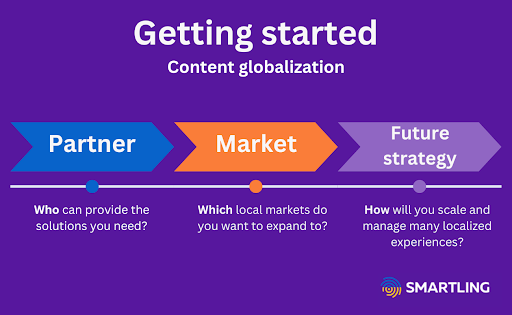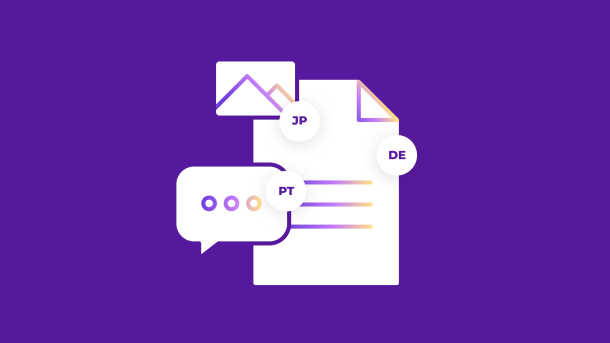Many brands face challenges expanding into new markets when their website, marketing materials, legal documents, and other customer-facing resources won’t connect with the intended multilingual target audience.
You can translate these resources, but it’ll take thousands of hours—and that’s just for the initial project. Moving forward, you’ll need a plan to translate future content consistently.
Even if you accomplish the initial translation tasks, you may miss the individual cultural nuances that require careful attention to get each resource translated correctly. Plus, it is difficult to scale the process into dozens of languages.
However, innovative content globalization makes scaling your company’s expansion efforts possible.
It lets you automate your process through a much more affordable and scalable strategy. And it means you can change the narrative so that localizing content no longer delays your time to market but gets you ahead and helps your brand connect with local audiences.
In this article, we’ll start with defining content globalization. Then, we’ll dive deeper into the practice and offer tips so you can get started. By the end of this article, you’ll have all the information you need to build a foundation to connect with multilingual audiences across the world.
What is content globalization?
While localization focuses on adapting your brand, customer support, and client-facing materials to a local audience, content globalization represents a specific foundation of the process—the ability to expand your content to new markets.
Content globalization occurs when companies redefine their content standards and infrastructure to support multilingual audiences worldwide. The process ensures that content can reach audiences in different languages and cultural contexts.
Content globalization vs. content localization
Globalization represents the bigger vision of expanding to reach multilingual audiences. This includes adapting the software, content standards, media strategies, and processes to enter international markets with different cultures.
Localization then focuses on the needs and cultural nuances associated with adapting the source language to the local dialect of each market. Companies need to translate content, adjust or switch specific images for cultural nuances, and make edits so that digital experiences feel localized to the user. Between cities like London and New York and cultures like Europe and Asia, there’s a lot to consider. And creating a big vision for how you can do that is essential.
So to get to the stage of content localization, we first need a content globalization strategy.
The importance of globalizing content
Have you ever visited another country and seen a restaurant that claims to be from your culture? They’re offering an “authentic” experience. You’re curious and excited to try a taste of home from abroad. Then, you take the first bite.
The burger has herbs you’ve never tasted, and the way the fries are cut is entirely new to you. While you enjoyed a unique experience, it’s only a shadow of the authentic version.
That’s how it can feel when someone visits your website from a different background. You promise a great product or service, but it feels foreign to them. Chinese, German, or British audiences would recognize an American or foreign brand in a heartbeat by the tone, word choice, and images you use. If you can’t authentically represent your brand throughout different markets in the world economy, you’ll limit your growth and your ability to connect with audiences.
Content globalization helps you create a strategy to uniquely serve customers in each market.
Once you globalize your initiatives, your website and materials will begin to produce new effects, such as:
- Increased sales due to better connections with customers
- Multiplied revenue growth from expanding into global markets
- More innovation due to accessing and working with different cultures
While content globalization may seem like a clear approach, it does come with challenges—especially if you’re doing it alone.
Tips for effective content globalization
Businesses face obstacles like content transformation and scalability, sustainable processes for new content, and cultural nuances and local government requirements with hundreds (if not thousands) of cultures and countries. The amount of resources it would take to translate effectively for all of these groups and manage materials daily seems impossible.
If companies leverage the proper globalization and localization software and teams, they won’t have to worry about these challenges and can focus on growth.

Ask yourself these questions when developing your strategy.
Brands can tackle the challenges by adopting a simple but clear approach. Here’s how to get started:
1. Find the right partner
You need a platform that can help you translate billions of words at fast speeds. You have a lot of source text to translate, and that requires sophisticated systems that can level the playing field. The same software should also automatically help you translate future content coming in so it’s sustainable.
Your globalization partner should help you establish a global solution for your website and materials so you can easily account for different languages, switch out media, adjust for different reading practices (like right to left for Arabic and Hebrew), and more.
The platform you choose should also allow you to add services to help you transition to content globalization and localize your strategy for each market. You don’t want to be left alone figuring it out by yourself. You need a partner who can help you not just set up your infrastructure but also succeed.
With Smartling’s translation management system (TMS), companies can experience 90% better on-time delivery, 42% faster time to market, and a 30% reduction in translation costs.
Along with Smartling’s technology, its human translators will help put your globalization strategy into high gear.
2. Choose your next market
As you globalize, consider the type of markets you want to tackle first. Ensure that you build the infrastructure, website, and processes to accommodate multilingual audiences.
Then, think about how you will scale. Are you prepared to translate billions of words to connect with a native audience? And when you do, can you translate more text in real time as you publish daily content across all markets?
Once you understand what it takes to enter and meet the needs of multiple markets, you’ll have a better idea of how to globalize your business content. You can reach new markets and expand your company by choosing growing economies in different countries and regions, whether it’s in France, China, Germany, or a country in Latin America.
3. Look far into the future
Finally, look ahead. What would it look like if you globalized your content for dozens of different languages and cultures? How would you manage it all? You want a seamless process that publishes timely content, updates text, and provides customers with an instantly localized experience when they visit your site.
This can’t be done with a human team alone (at least at scale) or with subpar globalization software.
You need a strategy and ecosystem that can handle the lofty goals that come with “global”—and the right approach and tools to make it possible.
Pitfalls to avoid in the globalization journey
In our experience, we’ve seen many companies jump into content globalization without considering the key factors that determine their success. Below are some of the most common mistakes we see:
1. You can’t assume you can do it alone
Content globalization is nearly impossible on your own—even for one language. At best, you could translate and localize your site for a different culture, but after an update, it’ll be outdated. Then you’d have to manage two different website versions and spend all your energy re-localizing your site.
When you partner with a platform, you automate your process. You don’t have to juggle multiple site versions and can use hundreds of different versions for many markets.
You go from frantically updating your site versions and offering a lower standard of experience to providing a native experience to as many markets as you want.
2. You don’t know as much as a local
Even if you spend 10 years living in a country, you’ll still miss some cultural nuances. Understanding a different group of people is a lifelong journey, and that’s why we should depend on a tool with an AI-powered human translation offering for the best translations.
Whether it’s the way someone dresses in an image, how viewers perceive the color red, or why the particular word you use affects the reader, every detail conveys a unique message. The wrong detail can negatively affect your customer relationship, while the right one can win loyal customers. Find a platform with access to services that can provide a native experience in every market.
3. You should recognize that one size doesn’t fit all
Even McDonald’s knows that its menu can’t be the same in every country and city. Your content globalization strategy should focus on adapting your product or service to each market’s unique needs.
Your Spanish-language site might only fit some Spanish-speaking cultures, from Spain to South America to Orlando. As you target each market, you should be able to offer the unique experiences required to connect with audiences, make sales, and build brand loyalty.
As soon as you’ve globalized your brand, focus on localization for each local audience.
How Smartling enables holistic content globalization
Content globalization provides many opportunities, such as increasing sales and connecting with audiences worldwide. The only obstacle in your way is a scalable and sustainable strategy.
Smartling offers the tools you need to build and automate your globalization strategy. It also provides additional human services to ensure that you have all the necessary resources and talent.
Smartling’s full-stack, all-in-one solution provides:
- Managed services: Outsource your localization management so you can focus on growth while we help you enter new markets.
- TMS: Centralize all your translations with a repository of content and a powerful admin suite to control every step of the process.
- Translation services: Leverage a team of 100% native-speaking translators who can make your content local.
- Smartling Translate: Use machine translation through a GPT-enabled portal that allows you to to produce up to 350% higher quality on-brand translations in seconds.
When you partner with Smartling, everything’s taken care of. You can enter new markets, localize your content, and expand your global reach with a brand that connects with audiences and increases sales. Start by watching our quick demo to see how it works.








